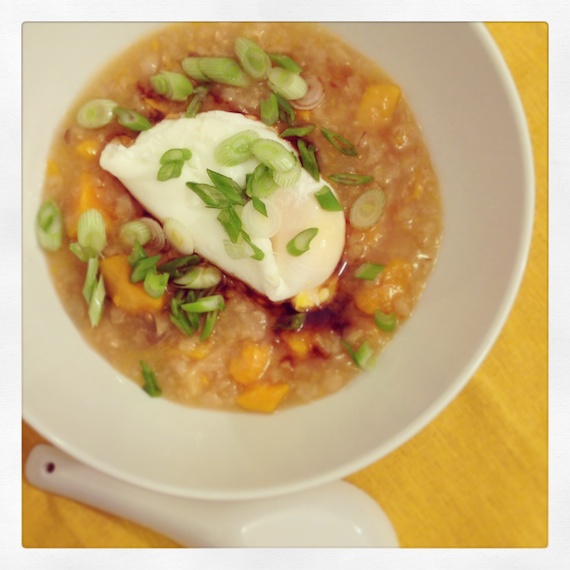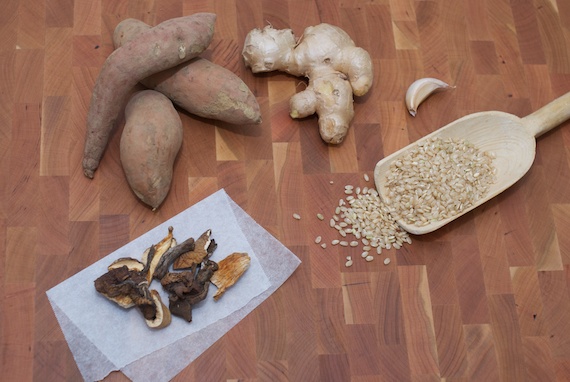 Living in Queens, there are ample opportunities for culinary inspiration, and dim sum brunch yesterday was merely one of those times. Heading out for dim sum means that there are many steamed buns, dumplings, and fried meat morsels in your future. However, before you get to the doughy goodness of steamed delectables, there is often an opportunity to start your day the way countless Chinese people here and abroad have started their days for centuries: with a bowl of congee.
Living in Queens, there are ample opportunities for culinary inspiration, and dim sum brunch yesterday was merely one of those times. Heading out for dim sum means that there are many steamed buns, dumplings, and fried meat morsels in your future. However, before you get to the doughy goodness of steamed delectables, there is often an opportunity to start your day the way countless Chinese people here and abroad have started their days for centuries: with a bowl of congee.
Congee, also termed jook, is unassumingly simple. To call it porridge would turn off too many people, as would calling it rice soup or even worse, gruel, but that is essentially what it is. Rice (or sometimes another grain) is cooked in an obscene amount of water – it wouldn’t be unheard of to use a 1:10 rice:water ratio – until the rice completely breaks down and the water and rice meld together into a gloopy, gelatinous, delicious stew. Congee is most often served at breakfast, but because it is so gentle on the body, it is also a traditional healing food, served to people convalescing from fevers, viruses and illness.
But back to dim sum: the jook cart rolled by, and I gestured for a bowl. A woman ladled out simple white porridge into a simple white bowl, garnishing with a small handful of scallions. Perfection! I am a huge fan of savory breakfasts, and as soon as I tasted this jook, I knew that it was this that I must cook (I really wanted to make that rhyme once during this post). When I was studying Chinese medicine, I experimented with congee, and I have gone through phases of jooking it up since, but it’s probably been a years or so. Matthew occasionally makes whole grains for breakfast, but never this thinned-down, soupy version. So last night I took out my slow cooker and started to assemble.

Jook is most often cooked with white rice since it tends to break down easier than brown rice, (and the affinity for brown rice is a relatively recent phenomenon) but when cooking jook in a slow cooker overnight, brown rice is just fine. In addition to the rice and water (1:7 ratio), I threw in a cubed sweet potato, grated ginger, some dried shitake mushrooms (fresh would work fine, too), one clove of minced garlic and some salt. Congee is often used as a vehicle for healing foods, and most of the ingredients I used do have the TCM healing properties of boosting the body’s natural energy. Long story short, while this is great to cook when you’re feeling weak or sick, it’s never NOT a good time to eat it!
Jook is gentle, nourishing and simple – it’s almost like a morning stretch, but for your digestion. Chinese medicine stresses the importance of gentle foods in the morning to avoid overwhelming the digestion, and jook does just that. 8-hours overnight on low did the trick for this lowly cup of brown rice. When I jumped out of bed to check on my jook this morning, I was thrilled with how the rice and sweet potato broke down, creating a gorgeous orange-y smooth soup. I decided to make the dish bit more substantial by topping with a poached egg, along with the requisite scallions and drizzle of sesame oil and tamari. I do tend to go more firmly in the savory direction for breakfast, but the sweet/savory combo in this dish was just what I needed this morning. If more of a sweet jook is what you’re after, throw in some walnuts, goji berries, dates or apples. If you’re craving some extra sustenance in the cold, winter months, cook the congee with a meaty bone. The possibilities really are endless. Many Asian cultures have their own version of jook, and I’m looking forward to searching Queens for more inspiration. If you cook jook at home, please comment below with your favorite combinations.
